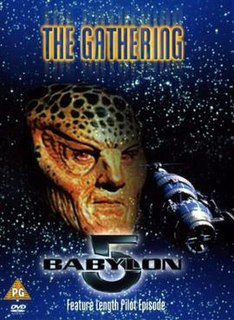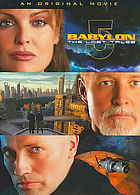Related Research Articles

Babylon 5 is an American space opera television series created by writer and producer J. Michael Straczynski, under the Babylonian Productions label, in association with Straczynski's Synthetic Worlds Ltd. and Warner Bros. Domestic Television. After the successful airing of a test pilot movie on February 22, 1993, Babylon 5: The Gathering, Warner Bros. commissioned the series for production in May 1993 as part of its Prime Time Entertainment Network (PTEN). The show premiered in the US on January 26, 1994, and ran for five 22-episode seasons.

Joseph Michael Straczynski is an American filmmaker and comic book writer. He is the founder of Synthetic Worlds Ltd. and Studio JMS and is best known as the creator of the science fiction television series Babylon 5 (1993–1998) and its spinoff Crusade (1999), as well as the series Jeremiah (2002–2004) and Sense8 (2015–2018). He is also the executor of the estate of Harlan Ellison.
"Midnight on the Firing Line" is the first episode of the first season of the science fiction television series, Babylon 5, following the pilot movie, "The Gathering". It first aired on January 26, 1994. It was notable for being the first regular television episode which used computer-generated imagery rather than physical models for its special visual effects. The episode also marked the beginning of the first science fiction television series where the entire series had an overarching storyline, which the writer J. Michael Straczynski described as "a novel for television".
"Soul Hunter" is the second episode of the first season of the science fiction television series, Babylon 5. It first aired on 2 February 1994.
"Infection" is the fourth episode of the first season of the science fiction television series, Babylon 5. "Infection" was the first script written for a regular Babylon 5 episode.
"The Parliament of Dreams" is the fifth episode of the first season of the science fiction television series, Babylon 5. The Babylon 5 makeup team won an Emmy Award for the special alien makeup design for this episode.
"Mind War" is the sixth episode of the first season of the science fiction television series, Babylon 5.
"The War Prayer" is the seventh episode of the first season of the science fiction television series, Babylon 5. It first aired on 9 March 1994.
"And the Sky Full of Stars" is the eighth episode of the first season of the science fiction television series, Babylon 5. It first aired on 16 March 1994.
"Deathwalker" is the ninth episode of the first season of the science fiction television series, Babylon 5. It first aired on 20 April 1994. '
"Survivors" is the eleventh episode of the first season of the science fiction television series, Babylon 5. It first aired on May 4, 1994.
"The Coming of Shadows" is a key episode from the second season of the science fiction television series Babylon 5. It won the 1996 Hugo Award for Best Dramatic Presentation.

John J. Sheridan is a lead character in the fictional universe of the science-fiction television series Babylon 5, played by Bruce Boxleitner. For most of the series, he is the commander of the Babylon 5 station; during the series' final season he is the President of the Interstellar Alliance.

G'Kar is a fictional character, played by Andreas Katsulas, in the universe of the science fiction television series Babylon 5. He initially appears as a villainous diplomat opposite Londo Mollari, being constantly engaged in insidious, if petty and often comical schemes, usually driven by his hostility to his people's historical enemies, the Centauri, whom Londo represents. However, in the course of the series, he is transformed into a Messianic figure and the foremost spiritual leader of his people.

Babylon 5: The Gathering is the test pilot movie of the science fiction television series Babylon 5, aired on February 22, 1993. It is also the first of six feature-length films in the Babylon 5 media franchise.
"Believers" is the tenth episode of the first season of the science fiction television series, Babylon 5. It first aired on April 27, 1994. It follows Dr. Franklin's ethical dilemma after he encounters a dying boy whose parents refuse to allow him to receive treatment that will save him, and Commander Susan Ivanova's mission to rescue a stranded transport ship in Raider territory.

Babylon 5: The Lost Tales was intended to be an anthology show set in the Babylon 5 universe. It was announced by J. Michael Straczynski, creator of Babylon 5, at the San Diego Comic Con in July 2006. Straczynski has described the stories as ones he had for the Babylon 5 television series, but never had the time to produce. Only one installment, titled Voices in the Dark, was produced before the project was shelved.
Babylon 5 is an American space opera television series created by writer and producer J. Michael Straczynski, under the Babylonian Productions label in association with Straczynski’s Synthetic Worlds Ltd. and Warner Bros. Domestic Television. After the successful airing of a pilot movie, Warner Bros. commissioned the series as part of the second year schedule of programs provided by its Prime Time Entertainment Network (PTEN). It premiered in the United States on January 26, 1994 and ran for the intended five seasons. Describing it as having "always been conceived as, fundamentally, a five year story, a novel for television", Straczynski wrote 92 of the 110 episodes and served as executive producer, along with Douglas Netter.
References
- ↑ DiTillio, Larry (1994). "Born to the Purple". Babylon 5. Season 1. Babylonian Productions. PTEN/Warner Brothers.
- ↑ "Television Academy: Babylon 5: Awards & Nominations". Television Academy. Academy of Television Arts & Sciences. Archived from the original on 2022-04-09. Retrieved 2022-04-05.
- ↑ Straczynski, J. Michael (17 February 1994). "Born to the Purple". JMSNews. J. Michael Straczynski. Archived from the original on 2022-04-06.
- ↑ Britt, Ryan (11 July 2019). "5 Things that Babylon 5 did that changed science fiction forever". www.syfy.com. SYFY Media LLC. Archived from the original on 2021-10-09.
And though this may seem shocking now, in the early and mid-'90s, CGI was not the default for sci-fi special effects. Most big sci-fi shows and movies (like Star Trek) all still used physical models, which are notoriously more expensive. But all of Babylon 5's spaceships and space stations were made in a computer.
- ↑ "Interviews: Ron Thornton". B5 Scrolls. Tom Smith. 2016.
- ↑ "How 24 Commodore Amiga 2000s created Babylon 5". GenerationAmiga.com. GenerationAmiga. 30 August 2020. Archived from the original on 2020-09-22.
- 1 2 "Extracts from interview with Adam 'mojo' Lebowitz". B5 Scrolls. Tom Smith. 2019. Archived from the original on 2022-04-08.
- 1 2 Straczynski, J. Michael (11 October 1993). "Next up is "Survivors."". JMSNews. J. Michael Straczynski. Archived from the original on 2022-04-06.
- ↑ Straczynski, J. Michael (6 August 1993). ""The Parliament of Dreams" is "Carnival!"..." JMSNews. J. Michael Straczynski. Archived from the original on 2022-04-06.
- 1 2 Kaiser, Rowan (15 June 2012). "Babylon 5: 'Born To The Purple'/'Infection'". The A.V. Club. G/O Media Inc.
- 1 2 Rosner, Elias (6 June 2018). "Five Thoughts on Babylon 5's 'Born to the Purple.'". Multiversity Comics. Matthew Meylikhov.